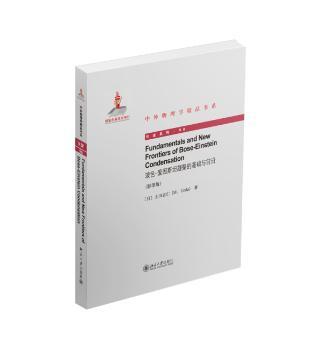内容简介
《玻色-爱因斯坦凝聚的基础与前沿》先介绍了玻色-爱因斯坦凝聚(BEC)的基本理论。之后,本书讨论了快速旋转BEC,旋量和偶极BEC,低维BEC等近来发展迅速的方向。本书还介绍了平衡或非平衡费米液体超流,包括BCS-BEC交叉、幺正气体、p波超流等。本书适合本领域的研究者和研究生阅读。
目录
Preface v
1. Fundamentals of Bose-Einstein Condensation 1
1.1 Indistinguishability of Identical Particles . . . . . . . . . . 1
1.2 Ideal Bose Gas in a Uniform System . . . . . . . . . . . . 3
1.3 Off-Diagonal Long-Range Order: Bose System . . . . . . 6
1.4 Off-Diagonal Long-Range Order: Fermi System . . . . . . 10
1.5 U(1)Gauge Symmetry . . . . . . . . . . . . . . . . . . . . 11
1.6 Ground-State Wave Function of a Bose System . . . . . . 13
1.7 BEC and Superfluidity . . . . . . . . . . . . . . . . . . . . 15
1.8 Two-FluidModel . . . . . . . . . . . . . . . . . . . . . . . 20
1.9 Fragmented Condensate . . . . . . . . . . . . . . . . . . . 23
1.9.1 Two-statemodel . . . . . . . . . . . . . . . . . . . 23
1.9.2 Degenerate double-well model . . . . . . . . . . . 25
1.9.3 Spin-1 antiferromagnetic BEC . . . . . . . . . . . 27
1.10 Interference Between Independent Condensates . . . . . . 28
1.11 Feshbach Resonance . . . . . . . . . . . . . . . . . . . . . 31
2. Weakly Interacting Bose Gas 33
2.1 Interactions Between Neutral Atoms . . . . . . . . . . . . 33
2.2 Pseudo-PotentialMethod . . . . . . . . . . . . . . . . . . 36
2.3 Bogoliubov Theory . . . . . . . . . . . . . . . . . . . . . . 40
2.3.1 Bogoliubov transformations . . . . . . . . . . . . . 40
2.3.2 Bogoliubov ground state . . . . . . . . . . . . . . 45
2.3.3 Low-lying excitations and condensate fraction . . 48
2.3.4 Properties of Bogoliubov ground state . . . . . . . 50
2.4 Bogoliubov Theory of Quasi-One-Dimensional Torus . . . 54
2.4.1 Case of BEC at rest: stability of BEC . . . . . . . 55
2.4.2 Case of rotating BEC: Landau criterion . . . . . . 56
2.4.3 Ground state of BEC in rotating torus . . . . . . 59
2.5 Bogoliubov-deGennes (BdG) Theory . . . . . . . . . . . 60
2.6 Method of Binary Collision Expansion . . . . . . . . . . . 65
2.6.1 Equation of state . . . . . . . . . . . . . . . . . . 65
2.6.2 Cluster expansion of partition function . . . . . . 66
2.6.3 Ideal Bose and Fermi gases . . . . . . . . . . . . . 67
2.6.4 Matsubara formula . . . . . . . . . . . . . . . . . 69
3. Trapped Systems 73
3.1 Ideal Bose Gas in a Harmonic Potential . . . . . . . . . . 73
3.1.1 Transition temperature . . . . . . . . . . . . . . . 75
3.1.2 Condensate fraction . . . . . . . . . . . . . . . . . 76
3.1.3 Chemical potential . . . . . . . . . . . . . . . . . 77
3.1.4 Specific heat . . . . . . . . . . . . . . . . . . . . . 77
3.2 BEC in One- and Two-Dimensional Parabolic Potentials . 79
3.2.1 Density of states . . . . . . . . . . . . . . . . . . . 79
3.2.2 Transition temperature . . . . . . . . . . . . . . . 79
3.2.3 Condensate fraction . . . . . . . . . . . . . . . . . 80
3.3 Semiclassical Distribution Function . . . . . . . . . . . . . 81
3.4 Gross-Pitaevskii Equation . . . . . . . . . . . . . . . . . . 83
3.5 Thomas-Fermi Appr




 VIP会员
VIP会员